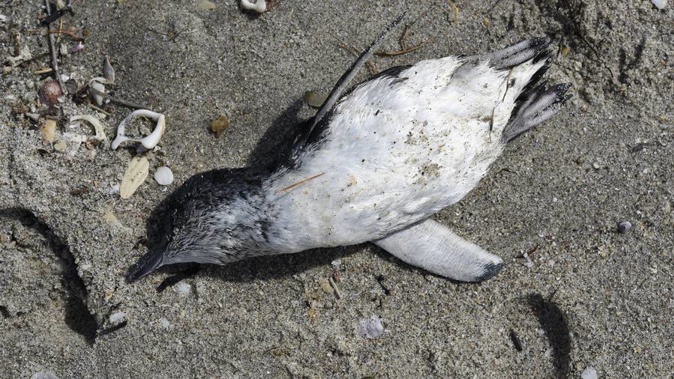
Rough seas and strong easterlies - and a successful breeding season - could be behind the deaths of possibly thousands of little blue penguins on Northland's east coast.
Many east coast beaches have been strewn with bodies of the world's smallest penguin species, in Maori called korora, along with shearwaters, petrels and other seabirds.
Although the sight has shocked some visitors to the region, even locals used to seeing dead seabirds are concerned at the number of birds in trouble and carcasses, Whangarei birdman Robert Webb said.
The Whangarei Bird Recovery Centre which he manages is caring for dozens of injured or exhausted seabirds brought in this week.
''The birds are copping it for sure in this weather. We've been inundated by them,'' Mr Webb said.
Yesterday he also dropped off a dozen or so blue penguin carcasses to the Department of Conservation in Whangarei which had been brought into the centre.
While the weather pattern is hammering the east coast, if it were on the west coast the centre would be caring for albatrosses and other big birds, as well as large numbers of penguins and small seabirds, he said.
As for the weak birds, people could help save some by lifting them from the water's edge if possible and putting them in dunes or grass banks where there was more shelter and they were away from high tide sweeps, Mr Webb said.
''Those that can't be saved will die anyway. Those with some chance might get a bit of strength back if they've got some protection from the elements.''
Other reasons for the deaths included penguins could be in their moult stage — when juvenile feathers are replaced, they are not waterproof and can't swim. Others could be youngsters whose parents have stopped feeding them, or old ones coming ashore anyway to die, as is usual for penguins.
Graeme Taylor, Department of Conservation's principal science adviser for marine species, said there's a strong correlation between El Nino and La Nina seasons and penguin deaths.
In El Nino years, with mainly westerly and southerly winds, seabirds that die at sea tend to wash up on west coast beaches. In La Nina years, with more northerly and easterly winds, seabirds get washed on to east coast beaches in summer and autumn.
''In northern New Zealand, blue penguins breed well in years with El Nino conditions — cooler, well oxygenated and productive seas,'' Mr Taylor said.
''We have recently had a big El Nino event and conditions have turned to La Nina this spring and summer with warmer than average seas. The productivity in the ocean has been good, producing lots of penguin chicks.''
It is likely lots of young chicks that left their nests earlier in the summer are now struggling to find food while they learn to fend for themselves at sea, he said.
Take your Radio, Podcasts and Music with you









